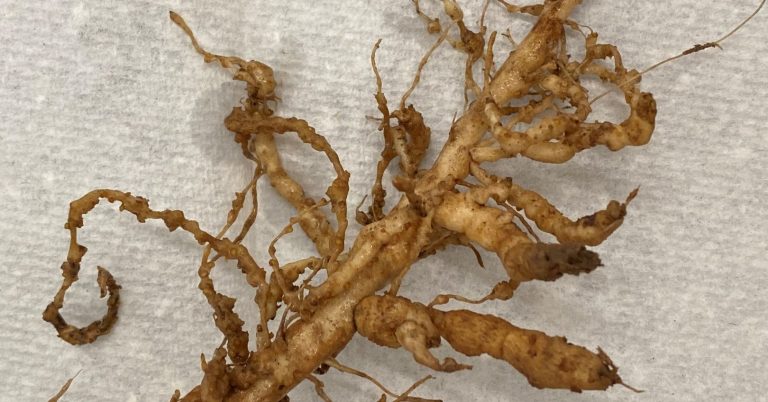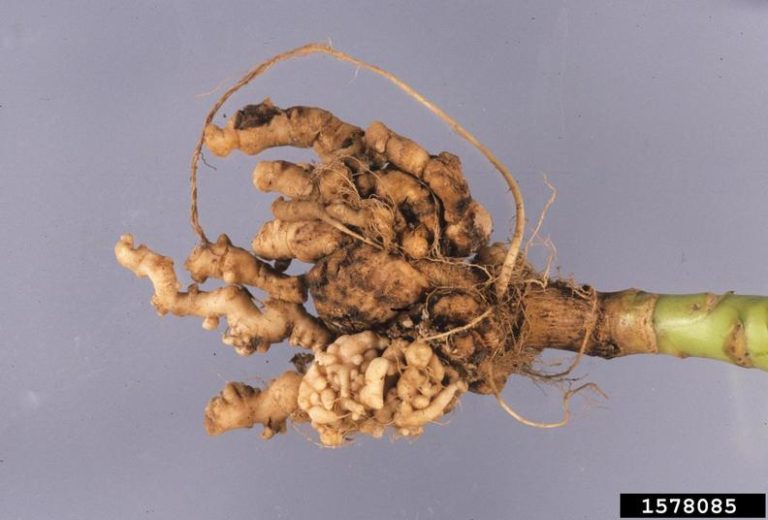Anthracnoses, derived from the Greek word anthrax meaning carbon or black, are fungal diseases characterized by the production of conidia within black acervuli. These diseases are primarily caused by four ascomycetous fungi: Diplocarpon, Elsinoe, Glomerella, and Gnomonia. In nature, these fungi are predominantly observed in their conidial stage and can survive through winter either as mycelium or conidia.
Anthracnose, a devastating disease caused by Glomerella( conidial stage: Colletotrichum or Gloeosporium) affects a wide range of vegetables and spices, leading to significant yield losses globally and in Nepal. Warm, humid climates prevalent in Nepal create favorable conditions for the disease, making it a persistent challenge for growers.
This blog post provides a comprehensive overview of anthracnose, covering its causative agents, disease cycle, symptoms, and management practices tailored to Nepal’s context.
Taxonomical Classification
| Taxonomic Rank | Details |
|---|---|
| Domain | Eukaryota |
| Kingdom | Fungi |
| Phylum | Ascomycota |
| Class | Sordariomycetes |
| Order | Glomerellales |
| Family | Glomerellaceae |
| Genus | Colletotrichum |
| Common Species | Colletotrichum gloeosporioides (widely studied), C. capsici, C. coccodes, C. acutatum, C. truncatum, C. fragariae, C. lindemuthianum |
Notes:
- Morphology:
- Produces acervuli (spore-producing structures) often with setae (dark, hair-like appendages).
- Conidia are single-celled, hyaline (colorless), and cylindrical or fusiform.
- Specialization:
- Colletotrichum species are known for their wide host range and can infect fruits, vegetables, cereals, and ornamental plants.
- Pathogenicity:
- They are primarily hemibiotrophs, starting as biotrophs (feeding on living host tissue) and later becoming necrotrophs (feeding on dead tissue).
Causative Agents of Anthracnose
Anthracnose is caused by fungi belonging to the genus Colletotrichum, with the most notable species including:
- Colletotrichum gloeosporioides
- Affects a wide range of crops, including chili, bell pepper, and eggplant.
- Colletotrichum capsici
- Highly virulent on chili and other Capsicum species.
- Colletotrichum orbiculare
- Specializes in cucurbits such as cucumber, pumpkin, and watermelon.
- Colletotrichum coccodes
- Common in solanaceous crops like tomato and eggplant.
- Colletotrichum lindemuthianum
- Common in beans (Phaseolus spp.)
- Colletotrichum circinans
- Causes onion anthracnose or smudge
- Colletotrichum lagenarium
- Causes anthracnose of cucurbits
- Colletotrichum phomoides
- Causes fruit rot of eggplant and tomato
Despite these fungal pathogens causing anthracnose in vegetables and spices, Colletotrichum species also infect fruits, pulses, and plantation crops as;
- Colletotrichum gloeosporiodes (Anthracnose of mango, papaya, grapes),
- Colletotrichum truncatum (Anthracnose of Blackgram and Lentil)
- Colletotrichum camellia (Anthracnose of tea)
- Colletotrichum falctum (Red rot of sugarcane)
- Colletotrichum acutatum
These fungi produce conidia (asexual spores) as the primary inoculum, enabling rapid infection under favorable conditions.
Disease Cycle
Anthracnose in vegetables and spices is primarily caused by various species of Colletotrichum, including Colletotrichum gloeosporioides, C. capsici, C. lindemuthianum, and C. truncatum. These species exhibit polycyclic behavior, completing multiple infection cycles within a growing season.
1. Primary Inoculum
- Survival Structures: The pathogen survives between growing seasons in infected plant debris, seeds, and soil. The primary survival structures include:
- Dormant mycelium in plant tissues.
- Conidia (asexual spores) produced in specialized fruiting bodies called acervuli.
- Sclerotia or microsclerotia in some species, which enhance survival under adverse conditions.
- Overwintering: In temperate regions, the pathogen overwinters in infected debris and seedborne infections. In tropical and subtropical areas, the pathogen persists throughout the year on alternate hosts or volunteer plants.
2. Dissemination of Inoculum
- Mechanisms of Spread:
- Rain-splash dispersal: Conidia from acervuli are splash-dispersed by rain or irrigation water.
- Wind: Fine droplets containing spores may travel short distances.
- Infected seeds: Seedborne inoculum is a critical primary source, especially in spices like chili and vegetables like beans.
- Tools and human activity: Mechanical transmission through contaminated pruning tools, gloves, or human contact with infected plants.
3. Infection Process
- Spore Germination:
- Conidia land on susceptible plant surfaces, typically young leaves, stems, flowers, or fruits.
- Under favorable environmental conditions (temperature 20–30°C and relative humidity >90%), conidia germinate within 6–12 hours of landing.
- A germ tube emerges from the spore and develops into an appressorium, a specialized infection structure.
- Penetration:
- The appressorium generates turgor pressure and mechanical force to penetrate the plant cuticle and epidermal layer.
- Some species also secrete enzymes like cutinases, cellulases, and pectinases to degrade plant cell walls and facilitate entry.
- Establishment:
- After penetration, the fungus colonizes plant tissues intercellularly and intracellularly.
- It forms secondary hyphae that spread within host tissues, causing necrosis and tissue collapse.
4. Symptom Development
- Initial Symptoms: Small, water-soaked lesions develop on leaves, stems, or fruits.
- Progression: Lesions enlarge, becoming sunken, dark, and often surrounded by a chlorotic halo.
- Advanced Symptoms:
- Acervuli develop within lesions, producing masses of conidia, which appear as slimy, salmon-colored spore masses.
- Severe infections lead to fruit rot, defoliation, and stem dieback.
5. Secondary Spread
- Polycyclic Nature: Once established, Colletotrichum produces multiple generations of spores during a single season.
- Rain-splashed or wind-driven conidia infect neighboring tissues and plants.
- Infection cycles repeat every 5–7 days under optimal conditions, intensifying disease severity.
6. Survival and Dormancy
- End of Growing Season:
- Infected plant debris left in the field serves as a reservoir for the pathogen.
- Conidia or dormant mycelium in debris or soil persists until the next season.
- Seeds harvested from infected plants may carry latent infections, serving as a source of inoculum for subsequent crops.
Key Environmental Conditions Favoring Disease
- Temperature: Optimal range of 20–30°C.
- Humidity: High humidity (>90%) or prolonged leaf wetness is critical for spore germination and infection.
- Rainfall and Irrigation: Promote spore dispersal and infection by creating moist conditions.
Interactions with Host
- Young, actively growing tissues are most susceptible.
- Nutrient deficiencies, mechanical injuries, or pest damage can exacerbate infection.
- Host resistance varies among cultivars and species.
By understanding this detailed disease cycle, effective management practices, including cultural, chemical, and biological controls, can be implemented to reduce losses caused by anthracnose.

Symptoms
Symptoms of anthracnose vary by host plant but generally include:
Foliage
- Small, round, or irregular water-soaked spots that enlarge and turn brown or black.
- Coalescence of spots leads to extensive leaf blight, premature defoliation, and reduced photosynthesis.

Source: CABI Digital Library
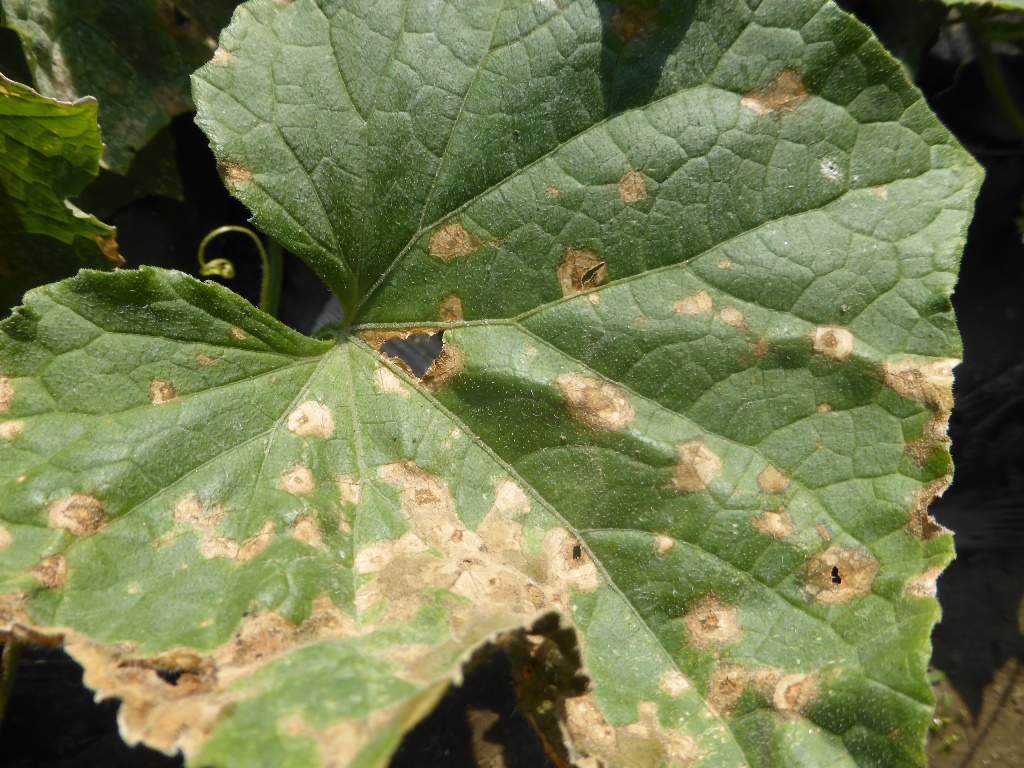
Source: K. Campbell-Nelson
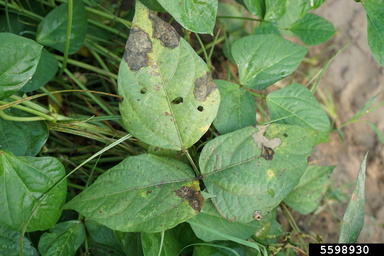
Source: RAJA J, ANNAMALAI UNIVERSITY, Bugwood.org
Fruits
- Sunken lesions with concentric rings, often accompanied by pinkish or orange spore masses.
- Severe infections cause fruit shriveling, cracking, and rotting.
- Unlike tomatoes, where symptoms appear only on mature (red) fruits, anthracnose in peppers can infect fruits at any stage of development.

Source: imexagro
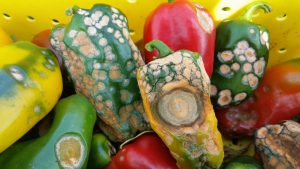
Source: Plant and Pest Advisory Rutgers Cooperative Extension
Source: University of Maryland (Extnesion)

Source: greenlife.co.ke
Stems and Petioles
- Elongated dark lesions that girdle stems and petioles, causing dieback.
- Severely infected stems may collapse, leading to plant death.
Specific Host Symptoms
- Chili and Bell Pepper (Capsicum spp.):
- Fruit rot is the most common symptom, with sunken black lesions.
- Cucumber (Cucumis sativus):
- Circular spots with a yellow halo on leaves and stems.
- Tomato (Solanum lycopersicum):
- Black, sunken spots on fruit, particularly at the blossom end.
- Spices (e.g., coriander, turmeric):
- Necrotic spots on leaves and stems; rot in fruits or rhizomes.
Favorable Conditions for Anthracnose
- Temperature: Optimal range is 20°C–30°C.
- Humidity: High humidity (>90%) is essential for spore germination and infection.
- Leaf Wetness: Prolonged leaf wetness from rain, dew, or irrigation favors fungal growth.
- Dense Planting: Poor airflow creates microenvironments conducive to fungal development.
Management Practices
Effective management of anthracnose requires an integrated approach involving cultural, biological, and chemical methods.
1. Cultural Practices
- Crop Rotation:
- Rotate with non-host crops such as cereals to break the disease cycle.
- Sanitation:
- Remove and destroy infected plant debris after harvest.
- Avoid using infected seeds for planting.
- Irrigation Management:
- Use drip irrigation to minimize leaf wetness.
- Avoid overhead irrigation, especially during the evening.
- Spacing and Pruning:
- Maintain adequate plant spacing to improve airflow.
- Regularly prune lower leaves to reduce humidity near the soil surface.
- Field Drainage:
- Ensure proper drainage to prevent waterlogging, which exacerbates fungal growth.
2. Resistant Varieties
- Select anthracnose-resistant or tolerant varieties of vegetables and spices where available.
3. Biological Control
- Use biocontrol agents such as:
- Trichoderma harzianum: Competes with Colletotrichum spp. for space and nutrients.
- Bacillus subtilis: Produces antifungal metabolites to suppress pathogen growth.
4. Chemical Control
- Apply fungicides judiciously, following a rotation schedule to prevent resistance development.
- Commonly used fungicides include:
- Contact Fungicides: Mancozeb, Chlorothalonil.
- Systemic Fungicides: Azoxystrobin, Propiconazole.
- Curative Fungicides: Carbendazim, Thiophanate-methyl.
5. Integrated Pest Management (IPM)
- Combine cultural, biological, and chemical practices for sustainable anthracnose management.
6. Post-Harvest Management
- Store harvested produce in dry, cool conditions to prevent latent infections from progressing.
- Use clean, sanitized containers for transport and storage.
Anthracnose in the Context of Nepal
Challenges in Nepal:
- High humidity and frequent rainfall during the monsoon season create ideal conditions for anthracnose outbreaks.
- Limited availability of disease-resistant varieties.
- Inadequate awareness among farmers about IPM strategies.
- Over-reliance on chemical fungicides, often without proper rotation, leading to fungicide resistance.
Solutions:
- Promote farmer training programs on disease identification and management.
- Strengthen access to resistant varieties and biocontrol agents.
- Improve irrigation infrastructure to reduce moisture on plant surfaces.
- Encourage collaboration between research institutions and local farmers for field trials and dissemination of improved practices.
Conclusion
Anthracnose remains a significant threat to vegetable and spice production, particularly in regions like Nepal with favorable climatic conditions. A holistic approach combining cultural, biological, and chemical methods is essential for effective management. Farmers, researchers, and policymakers must work together to implement sustainable practices, ensuring the long-term productivity and profitability of vegetable and spice farming.
By addressing the root causes and adopting integrated management practices, the impacts of anthracnose can be minimized, securing food security and farmer livelihoods in Nepal and beyond



